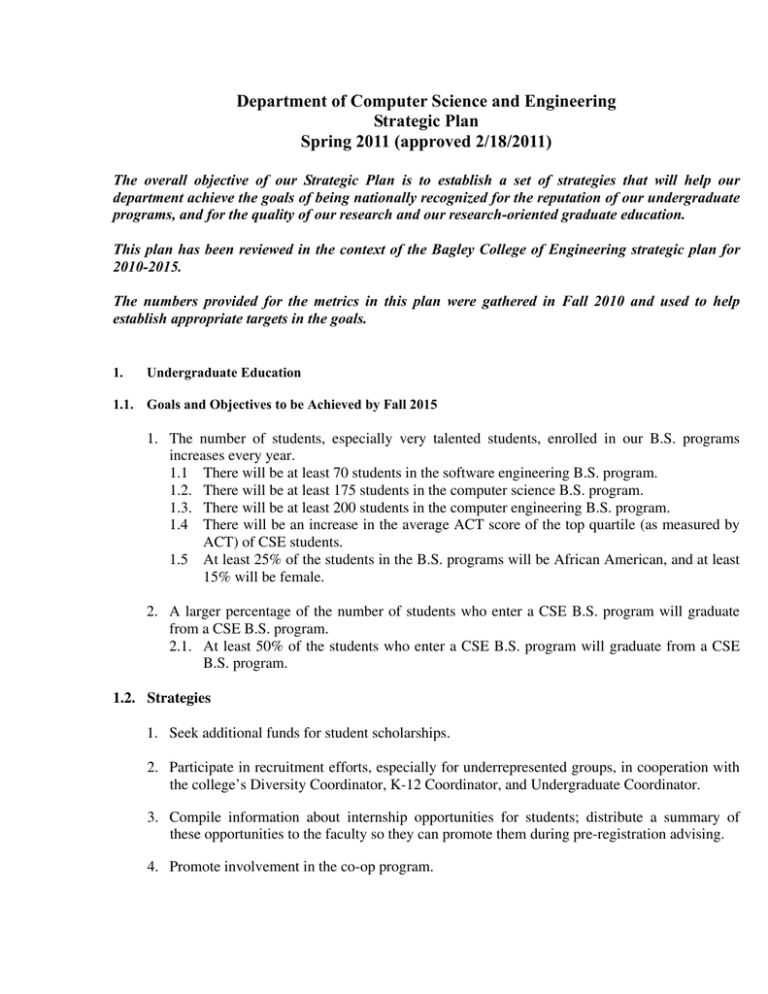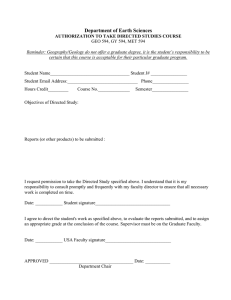Department of Computer Science and Engineering Strategic Plan Spring 2011 (approved 2/18/2011)
advertisement

Department of Computer Science and Engineering Strategic Plan Spring 2011 (approved 2/18/2011) The overall objective of our Strategic Plan is to establish a set of strategies that will help our department achieve the goals of being nationally recognized for the reputation of our undergraduate programs, and for the quality of our research and our research-oriented graduate education. This plan has been reviewed in the context of the Bagley College of Engineering strategic plan for 2010-2015. The numbers provided for the metrics in this plan were gathered in Fall 2010 and used to help establish appropriate targets in the goals. 1. Undergraduate Education 1.1. Goals and Objectives to be Achieved by Fall 2015 1. The number of students, especially very talented students, enrolled in our B.S. programs increases every year. 1.1 There will be at least 70 students in the software engineering B.S. program. 1.2. There will be at least 175 students in the computer science B.S. program. 1.3. There will be at least 200 students in the computer engineering B.S. program. 1.4 There will be an increase in the average ACT score of the top quartile (as measured by ACT) of CSE students. 1.5 At least 25% of the students in the B.S. programs will be African American, and at least 15% will be female. 2. A larger percentage of the number of students who enter a CSE B.S. program will graduate from a CSE B.S. program. 2.1. At least 50% of the students who enter a CSE B.S. program will graduate from a CSE B.S. program. 1.2. Strategies 1. Seek additional funds for student scholarships. 2. Participate in recruitment efforts, especially for underrepresented groups, in cooperation with the college’s Diversity Coordinator, K-12 Coordinator, and Undergraduate Coordinator. 3. Compile information about internship opportunities for students; distribute a summary of these opportunities to the faculty so they can promote them during pre-registration advising. 4. Promote involvement in the co-op program. 5. Advertise opportunities such as internships, co-op participation, scholarships, and the waiver of out-of-state tuition for students with high ACT scores on the department’s web site and other appropriate places attractive to students (e.g., Facebook). Include student testimonials on the department’s web site. Coordinate advertising efforts with university recruiters and the admissions office. Place informational video about the department on YouTube. 6. Build a sense of community among the students by having a more active ACM chapter (with both social and technical activities) and an area of the building where students can gather. 7. Encourage more social interaction among the faculty and students. 8. Encourage retention by having ACM members talk to the freshman students about their majors and by teaching time-management skills in an introductory course. 9. Provide more tutoring for students, especially peer tutoring from juniors and seniors. 10. Provide employment opportunity information to parents of prospective freshmen. 1.3. Metrics 1. Enrollments in each B.S. program (including a breakdown by classification - freshman, sophomore, etc.) 2. Five-year window: # of CSE graduates in year 5 / # of CSE majors in year 1 3. Number of student scholarships by type (unrestricted and other) 4. Average ACT score of top quartile of CSE students 5. Membership in ACM and number of ACM events per year 6. Membership in UPE 2. Research and Graduate Education 2.1. Goals and Objectives 1. The number and quality of graduate students enrolled in our program, especially the number of Ph.D. students, increases. 1.1. By Fall 2015, there will be at least 80 graduate students (about 5 per faculty member) enrolled in the computer science program; at least 50% of these students will be Ph.D. students. 1.2. By 2019-20, there will be at least 5 Ph.D. students and 20 M.S. students graduating from the computer science program each year. Page 2 of 5 2. The funding in the department for graduate education will increase. 2.1. By Fall 2015, there will be enough funding generated in the department to support at least 90% of the Ph.D. students. 2.2. By Fall 2015, there will be funding available in the department to make an offer of a graduate assistantship to at least two highly qualified applicants to the Ph.D. program each year. 3. The research activity in the department will increase. 3.1. By FY 2016, the annual research expenditures in the department will be at least $3,500,000. Research expenditures include all expenditures for research (both direct and indirect) generated by CSE faculty through external funding. This includes funding administered through research centers. 3.2. By Fall 2015, faculty members will publish an average of at least 3.5 refereed papers per year, with an average of at least 1 journal paper per year. 3.3. At least 80% of the faculty are actively involved in research (e.g., publications, funding, direction of graduate students). 2.2. Strategies 1. Participate in graduate student recruiting programs of the college. 2. Seek national graduate fellowships (such as NSF IGERT). 3. Expect each active researcher to be principal investigator or co-principal investigator of a currently funded or to have proposed at least two peer-reviewed research grants each year. 4. Participate in collaborative research with other departments and other institutions, and in center-based research, recognizing the importance of participation as co-PI or investigator on such projects. To build collaborations, graduate faculty are encouraged to attend and present interdisciplinary seminars throughout the university and to invite outside speakers to present at departmental seminars.. 5. Develop small-group seminars (possibly organized by research areas) in which Ph.D. students regularly present and discuss their research. 6. Conduct yearly reviews of the status of all Ph.D. students by the entire graduate faculty. 7. Develop a set of practices regarding stipend, office space, and other methods of recognition that differentiate Ph.D. students who have passed the qualifying examination and who are actively involved in research from M.S. students and new Ph.D. students. 8. Obtain NSF Research Experience for Undergraduates (REU) grants for the academic year and Page 3 of 5 summer. 9. Host prospective Ph.D. students for visits to the department. 10. Work with the Development Office of the college to increase the number of scholarships. Increase the number of continuing fellowships available to students. Encourage and mentor students to apply for external fellowships. 2.3. Metrics 1. Number of Ph.D. students 2. Number of Ph.D. students supported by research grants 3. Number of Ph.D. graduates each year 4. Number of M.S. students 5. Number of M.S. graduates each year 6. Number of our M.S. students who enter our Ph.D. program each year 7. Number of our B.S. students who enter our graduate program each year 8. Annual research expenditures for the department (as defined in the Goals and Objectives) 9. Average number of journals and highly refereed conference papers published by faculty each year 3. Service and Outreach 3.1. Goals and Objectives 1. Increase the national/international visibility of the department through the involvement of faculty members and students in professional activities. 1.1. By Fall 2015, at least 75% of the faculty members will be involved in national/international professional service activities such as journal editor, editorial board member, conference program/organizing committee member, professional society officer, or accreditation site visitor. 1.2. By Fall 2015, at least 10% of the students are involved in professional service activities such as reviewing papers for conferences and journals, holding leadership positions in professional organizations (e.g., the student chapter of the ACM or Upsilon Pi Epsilon), and serving as student volunteers for conferences. 2. Increase the number of faculty members and students who interact with the community in Page 4 of 5 some form of professional outreach activity. 2.1 By Fall 2015, at least 10% of the faculty and students are engaged in some form of professional outreach activity. 3.2. Strategies 1. Encourage, recognize, and provide financial support to faculty members and students who attain leadership roles in professional and scientific organizations. 2. Encourage and recognize faculty members who participate in accreditation bodies. 3. Encourage faculty members to serve on professional and scientific review panels (e.g., NSF and DoD). 4. Encourage faculty members to give presentations about the department and its programs to statewide and civic organizations. 3.3. Metrics 1. Number of faculty members involved in national/international professional activities 2. Number of students involved in professional service activities 3. Number of faculty members and students involved in some form of professional outreach Page 5 of 5



